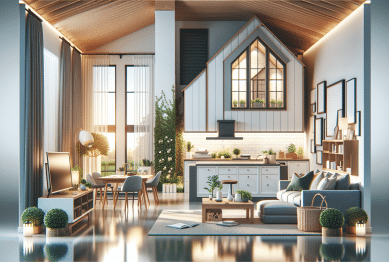Exploring the rise of accessory dwelling units offers valuable insight into affordable housing trends and investment strategy. Discover how ADUs change residential zoning, boost property value, and spark creative approaches to multigenerational living.
Understanding Accessory Dwelling Units
Accessory dwelling units, or ADUs, are becoming a sought-after housing solution in many cities. These smaller residences, sometimes called backyard cottages or in-law suites, can be attached or detached from the main home. Their growing popularity is linked to evolving zoning laws and increased demand for flexible living arrangements. For homeowners, ADUs represent a creative way to maximize property spaces. They may serve as rental units, home offices, or spaces for extended family, offering both convenience and extra income options. The flexibility they bring is a major draw for urban and suburban communities alike.
What makes accessory dwelling units stand out in the housing market is their diverse use scenarios. Long-term tenants, aging relatives, or young adults moving back home can all benefit from this separate space. Cities with limited land supply see ADUs as a path to gentle density increase that complements neighborhoods’ existing character. This housing style directly addresses affordability, allowing some owners to offset mortgages with rental revenue. Local governments are updating ordinances, making it easier than before for property owners to add these structures to their lots. The combination of regulatory shifts and demographic needs places ADUs at the forefront of urban planning discussions.
Learning about the legal, financial, and design aspects of ADUs is key for anyone considering this option. While requirements can vary widely, most regions set limits on size, entryways, and utility connectivity. Funding, too, can pose questions—some homeowners explore home equity lines or construction loans to finance their new unit. Understanding building codes and the permitting process early on helps avoid delays. Ultimately, accessory dwelling units offer a promising solution for addressing housing shortages, increasing property value, and adapting to changing household dynamics. Those who research thoroughly often discover a blend of flexibility, utility, and growth potential in ADUs.
The Impact of ADUs on Property Value and Community
Adding an accessory dwelling unit can significantly boost a property’s market appeal. Many real estate professionals recognize ADUs as an amenity that enhances overall value, especially in high-demand neighborhoods. When appraising properties, lenders and buyers often factor in the potential for rental income from an ADU. This revenue stream creates a compelling case for investment, attracting both owner-occupants and investors. Some homeowners discover that the added space increases resale flexibility, making the property attractive to multigenerational families or those seeking supplementary income.
Beyond individual property value, accessory dwelling units influence community dynamics. With greater housing variety, neighborhoods can welcome residents from diverse backgrounds and life stages. ADUs provide a discreet solution to the increasing need for affordable rentals without dramatic changes to a community’s appearance. This approach supports gradual density increases without large-scale development, keeping the neighborhood feel intact. Policy makers view ADUs as a tool to expand housing supply and support workforce accommodation in urban and suburban markets.
Community organizations also recognize the social benefits. Accessory dwelling units make it easier for seniors to age in place while staying close to loved ones. These spaces can facilitate care arrangements or foster supportive living environments for disabled family members. As a result, ADUs help communities maintain stable populations and connected social networks. In cities struggling with rising rents, these innovative dwellings offer options that support a broad cross-section of residents, sustaining community values and neighborly ties.
Navigating Zoning and Legal Considerations for ADUs
Building an accessory dwelling unit involves careful navigation of local zoning laws and permitting programs. Regulations vary widely across jurisdictions and often dictate the size, type, and location of an ADU on a property. Some cities impose minimum lot size, parking, or owner-occupancy requirements, while others provide streamlined approval to stimulate construction. Staying informed about municipal codes and legal updates is crucial for homeowners considering an ADU.
Permitting processes typically include submitting detailed plans, paying relevant fees, and scheduling inspections. Compliance with building codes ensures that the new structure is safe and functional, but may require upgrades to utilities or accessibility features. Legal experts sometimes assist in interpreting overlapping requirements, especially in areas where state and local policies are in flux. The rise of ADUs has prompted many cities to review and simplify regulations, aiming to encourage sustainable infill and affordable housing development.
Ignoring legal requirements can result in substantial delays or penalties. That’s why researching the specific rules in your area—consulting city planning offices or authorized resources—helps prevent missteps. Some local governments publish ADU handbooks or provide online tools for evaluating potential projects. Homeowners who are proactive in obtaining permits and adhering to zoning requirements enjoy smoother construction experiences and long-term peace of mind. Ensuring proper documentation sets the stage for successful, hassle-free ADU ownership and operation.
Funding, Construction, and Design Tips for ADUs
The cost of building an accessory dwelling unit varies based on design, materials, and location. Many homeowners tap into savings, home equity lines, or specialized renovation loans to fund their projects. Some localities even offer grants or incentives to encourage ADU construction, especially when these dwellings help address affordable housing needs. Budgeting for site preparation, utility connections, and furnishings creates a realistic framework for the project. Professional builders and architects can provide estimates to guide decisions and avoid surprise expenses along the way.
Design plays a pivotal role in ensuring both comfort and functionality. Compact kitchens, efficient storage, and large windows create a sense of spaciousness despite the smaller footprint. Some property owners opt for pre-approved or modular designs, speeding up the construction timeline. Solar panels and sustainable materials are increasingly integrated into ADUs, reflecting broader trends in green building and energy efficiency. Prioritizing natural light and ventilation contributes to healthy living environments while minimizing energy costs. Discussing options with contractors who have specific ADU experience can yield creative solutions for challenging sites.
Construction timelines for accessory dwelling units vary, typically ranging from a few months to a year depending on scope and regulatory complexity. Careful project management, regular check-ins, and open communication with builders can help address issues promptly. It’s wise to anticipate delays related to permitting, weather, or supply chain constraints. Upon completion, thoughtful landscaping enhances privacy and curb appeal, making the new unit blend seamlessly into the property. Success in ADU construction hinges on careful planning, quality craftsmanship, and flexibility in response to unforeseen challenges.
Exploring Rental Markets and Tenant Dynamics with ADUs
Rental potential represents a major motivation for constructing an accessory dwelling unit. In tight housing markets, ADUs offer tenants lower-cost options less commonly found in traditional apartment complexes. For landlords, this means reliable demand and the flexibility to choose between short-term or long-term renters. Understanding local rental regulations, lease terms, and tenant rights provides a smooth entry into property management. In some areas, regulations dictate who can occupy an ADU or require specific lease provisions.
Tenant selection and relationship management are crucial to creating a positive rental environment. Screening for finances, references, and compatibility with the property’s location helps set clear expectations. Many homeowners prefer to rent ADUs to students, relatives, or remote workers seeking independent space. Technology makes leasing and maintenance easier, from digital lease platforms to remote management tools. Adopting a professional approach to rental management builds stable, mutually beneficial arrangements between property owners and tenants.
Market conditions can fluctuate, affecting rental rates and occupancy levels for ADUs. Landlords may adjust their offerings or explore partnerships with local agencies to provide affordable housing. Some programs offer tax incentives or streamlined approvals for ADUs designated as long-term affordable rentals. Keeping up with trends in demand and tenant preferences equips property owners to adapt their strategy over time. Through careful planning and proactive management, accessory dwelling units become a resilient real estate investment option.
Future Trends and Sustainable Growth Through ADUs
Accessory dwelling units are expected to play a larger role in urban development as cities adapt to demographic and economic pressures. Growing populations, climate change, and shifts in work patterns all drive demand for flexible, efficient housing solutions. ADUs illustrate a “gentle density” approach that provides new homes without upending neighborhood character. Housing advocates, city planners, and homeowners alike are examining the potential of ADUs to foster inclusive, sustainable communities.
Sustainability is central to modern ADU design. Many new units incorporate energy-efficient systems, water-saving fixtures, and recycled materials. Urban planners encourage developments that minimize environmental impact while enhancing quality of life. As policies evolve, expect greener codes and incentives that reward eco-friendly construction. Educating the public about sustainable practices and long-term benefits strengthens support for ADU adoption and responsible growth in residential areas.
The integration of technology—like smart home features, remote management systems, and solar power—enhances the efficiency and appeal of accessory dwelling units. With increased acceptance and streamlined approvals, homeowners from a wide range of backgrounds can explore the benefits of ADUs. By staying informed on current trends and future projections, those interested in real estate or housing policy may find inspiration and opportunity in this adaptable form of living. The future of housing could be shaped, in part, by the thoughtful expansion of accessory dwelling units.
References
1. U.S. Department of Housing and Urban Development. (n.d.). Accessory Dwelling Units. Retrieved from https://www.huduser.gov/portal/pdredge/pdr-edge-trending-110419.html
2. AARP. (n.d.). The ABCs of ADUs: A guide to Accessory Dwelling Units & How They Expand Housing Options for People of All Ages. Retrieved from https://www.aarp.org/livable-communities/housing/info-2019/accessory-dwelling-units.html
3. Urban Institute. (2022). Estimating the Housing Supply Impacts of Adding ADUs. Retrieved from https://www.urban.org/research/publication/estimating-housing-supply-impacts-adding-adus
4. California Department of Housing and Community Development. (2022). Accessory Dwelling Unit Handbook. Retrieved from https://www.hcd.ca.gov/policy-research/accessory-dwelling-units
5. Freddie Mac. (2020). ADUs: Adding New Rental Housing in the Backyards of America. Retrieved from https://www.freddiemac.com/research/insight/20200812-accessory-dwelling-units
6. National Association of Realtors. (2021). Accessory Dwelling Units Can Help Ease Housing Shortage. Retrieved from https://www.nar.realtor/magazine/real-estate-news/accessory-dwelling-units-can-help-ease-housing-shortage









